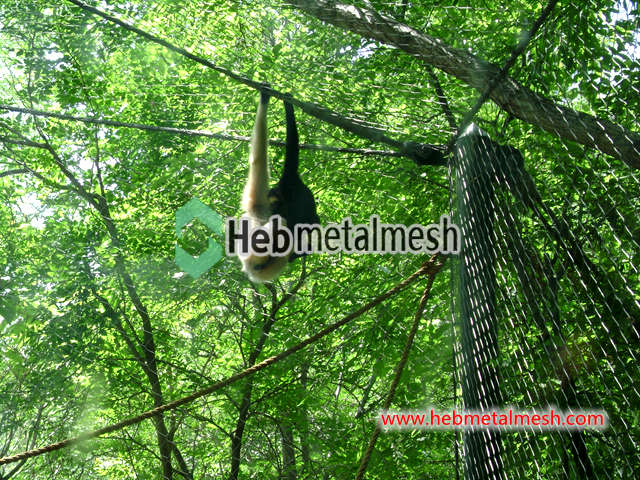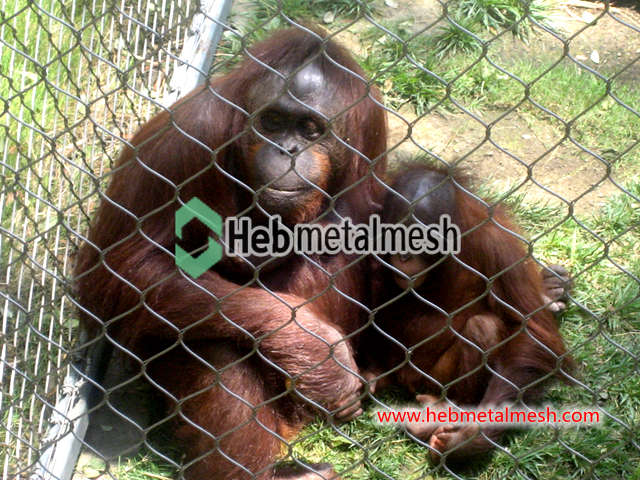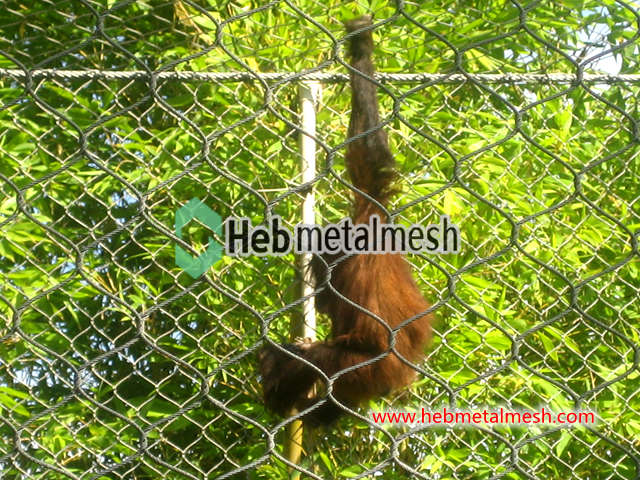Introduction
Creating a safe and stimulating home for your gibbons is essential for their well-being. A thoughtfully designed gibbon enclosure is more than just a place to live; it’s a world where they can thrive. The right choice of materials is crucial for both their safety and comfort.
Stainless steel gibbon cage netting stands out as a top-tier option for primate enclosures. Its durability, strength, and visibility make it a preferred choice among zookeepers and animal care professionals. But that’s not all. We’ll also dive into the exciting world of stainless steel rope mesh, a versatile alternative that can add a unique touch to your gibbon habitat.
Let’s explore the benefits of both options and discover how to create an optimal environment for your precious primates.
✌Gibbon Netting: A Better Choose For Gibbon Enclosure Mesh

Why Stainless Steel is the Ideal Choice for Gibbon Cage Netting
Gibbons are incredibly agile and intelligent creatures. Ensuring their safety is paramount when designing their enclosure. That’s where stainless steel gibbon cage netting shines.
Unlike traditional materials that can rust, corrode, or weaken over time, stainless steel is built to last. It’s a robust choice that can withstand the elements, ensuring your gibbon’s safety remains a top priority. Imagine a material that doesn’t succumb to the wear and tear of outdoor conditions. Stainless steel delivers on this promise.
But it’s not just about durability. Stainless steel offers excellent visibility. You can easily monitor your gibbons’ behavior without obstruction. This is crucial for animal care and research. Plus, the clean, modern look of stainless steel complements any zoo or sanctuary environment.
When it comes to protecting your precious primates, choosing stainless steel gibbon cage netting is an investment in their long-term well-being. It’s a decision that prioritizes safety, durability, and the overall quality of your gibbon enclosure.
Stainless Steel Rope Mesh: A Versatile Option for Gibbon Enclosures
While stainless steel netting is a fantastic choice, there’s another innovative option to consider: stainless steel rope mesh. This versatile material offers a unique blend of strength and flexibility, making it an excellent choice for creating dynamic and enriching gibbon enclosures.
Imagine a netting material that’s not only strong but also visually appealing. Stainless steel rope mesh provides a softer, more natural look compared to traditional netting. This can reduce visual barriers, allowing visitors to enjoy a more immersive experience while observing your gibbons. Additionally, the mesh’s flexibility can be used to create various shapes and configurations, encouraging exploration and stimulating your gibbons’ natural instincts.
By incorporating stainless steel rope mesh into your enclosure design, you can elevate the overall experience for both your gibbons and your visitors.

Essential Features of High-Quality Gibbon Cage Netting
Choosing the right gibbon cage netting involves considering several key factors. The mesh size is crucial for ensuring the safety of your gibbons while allowing for adequate ventilation. A mesh too large could pose a risk, while one too small might restrict their movement.
The wire diameter is another important aspect. A thicker wire provides greater strength and durability, essential for preventing accidental escapes or injuries. Look for netting made from high-quality stainless steel, preferably with a grade that offers excellent corrosion resistance.
Additional features to consider include UV resistance and weatherproofing. These qualities protect the netting from degradation, ensuring its longevity and maintaining a safe environment for your gibbons.
By carefully selecting netting with these essential features, you’re investing in a product that will not only protect your gibbons but also stand the test of time.
Installation Best Practices for Gibbon Cage Netting
Proper installation is crucial for the safety and longevity of your gibbon cage netting. Whether you’re using stainless steel netting or rope mesh, careful planning and execution are essential.
Start by measuring your enclosure accurately to determine the exact amount of netting needed. Consider factors like ground clearance and overlap when cutting your materials. Always wear appropriate safety gear during installation, including gloves and protective eyewear.
When securing the netting to the cage frame, use high-quality fasteners designed for outdoor use. Ensure the netting is taut but not overly stretched, as this can affect its durability. Regularly inspect the netting and fasteners for signs of wear or damage.
Remember, a well-installed gibbon cage netting system is not only essential for the safety of your primates but also contributes to the overall aesthetics of your enclosure.
Creating a Stimulating Gibbon Enclosure with Netting
A gibbon’s natural habitat is a complex environment filled with opportunities for climbing, swinging, and exploring. Replicating this in captivity is essential for their physical and mental well-being. Stainless steel and rope mesh netting can play a vital role in creating a stimulating enclosure.
By incorporating various heights and angles into your netting design, you can encourage natural behaviors like brachiation. Consider adding climbing structures or platforms within the enclosure to provide additional enrichment. Remember, the goal is to create a space that challenges your gibbons and keeps them engaged.
A stimulating environment not only improves the quality of life for your gibbons but also enhances the visitor experience.
Safety First: Preventing Injuries with Gibbon Cage Netting
The safety of your gibbons is paramount. While stainless steel and rope mesh are incredibly strong, it’s essential to prioritize injury prevention. Regular inspections are key to identifying any potential hazards. Check for signs of wear, tear, or loose fasteners.
Sharp edges should be avoided at all costs. Smooth finishes on the netting and enclosure frame can help prevent cuts and abrasions. Additionally, ensure there are no gaps or openings where a gibbon could become trapped.
By following these safety guidelines and conducting routine inspections, you can create a secure environment for your gibbons to thrive. Remember, prevention is always better than cure when it comes to animal welfare.
FAQ
Stainless steel and rope mesh are both excellent choices for gibbon cage netting. Stainless steel offers exceptional durability and visibility, while rope mesh provides a more natural look and can be used to create stimulating environments. The best material for your enclosure will depend on your specific needs and preferences.
Selecting the appropriate mesh size is crucial for gibbon safety. A general guideline is to choose a mesh size that prevents your gibbons from escaping while allowing for adequate ventilation. However, it’s essential to consult with a wildlife expert or veterinarian to determine the ideal mesh size for your specific gibbon species.
Absolutely! Stainless steel netting is highly resistant to corrosion and weathering, making it an ideal choice for outdoor gibbon enclosures. It can withstand various climatic conditions without compromising its integrity.
Regular inspections are essential to ensure the safety of your gibbons. It’s recommended to inspect the netting at least once a month, looking for signs of wear, tear, or damage. Promptly address any issues to prevent accidents.
While it’s possible to install gibbon cage netting on your own, professional installation is often recommended to guarantee proper installation and safety. If you decide to install it yourself, ensure you follow the manufacturer’s guidelines and take necessary precautions.
Conclusion
Providing a safe, stimulating, and durable environment for your gibbons is a top priority. Stainless steel and rope mesh netting offer exceptional solutions to meet these needs. By carefully considering factors like mesh size, wire diameter, and installation, you can create an enclosure that not only protects your primates but also enhances their quality of life.
Remember, regular inspections and maintenance are key to ensuring the long-term safety of your gibbon cage netting. Investing in high-quality materials and professional installation will pay dividends in the well-being of your precious animals.


